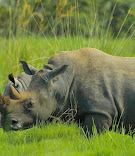Garamba National Park, Democratic Republic of the Congo
🐘 Garamba National Park – One of Africa’s Oldest and Wildest Sanctuaries
🗺️ Overview & Location
Garamba National Park is located in the northeastern corner of the Democratic Republic of the Congo, near the border with South Sudan, in Haut-Uélé Province. Established in 1938, it is one of Africa’s oldest national parks and was declared a UNESCO World Heritage Site in 1980 for its ecological richness and iconic wildlife.
Covering around 5,200 square kilometers (2,000 square miles), the park is a mixture of savannas, woodlands, and grasslands, dotted with rivers, wetlands, and gallery forests. It forms part of the wider Garamba Complex, which includes surrounding reserves and buffer zones that are critical for migratory species.
🦏 Wildlife & Biodiversity
Garamba was once famous for being the last home of the northern white rhinoceros, now functionally extinct. Despite this tragic loss, the park remains one of the few places in central Africa where you can still find:
-
African elephants (including both savanna and forest hybrids)
-
Kordofan giraffes – a rare and endangered subspecies
-
Lions, leopards, hippos, and buffalo
-
Giant elands, bushbucks, and various antelope
-
Over 300 bird species
This blend of savanna and forest species makes Garamba unique — a rare meeting ground of east and central African wildlife.
🛡️ Conservation & Challenges
Garamba faces severe challenges, including poaching, armed conflicts, and illegal mining activities in nearby areas. Decades of instability in eastern DRC and across the border in South Sudan have impacted the park’s safety and wildlife populations.
However, significant conservation efforts led by African Parks (since 2005), in partnership with the Congolese Institute for Nature Conservation (ICCN), have made notable progress:
-
Increased aerial and ground patrols
-
Community education and engagement
-
Elephant protection and habitat restoration
🧭 Travel Experience
Tourism in Garamba is limited and primarily for serious eco-travelers, researchers, and wildlife enthusiasts. Due to its remote location and past instability, visits are typically organized through conservation programs or NGOs working in the area.
-
Access: Via charter flight to Nagero Station, the park headquarters.
-
Best time to visit: December to March and June to September, during the dry seasons.
-
Accommodation: Rustic lodges and camps used by researchers and park rangers.
-
Activities: Guided safaris, bird watching, conservation tours, and cultural visits to local communities.
🌍 Cultural Context
The surrounding communities include the Azande people, known for their farming and rich oral traditions. Engagement with locals is encouraged through community-based conservation, offering visitors insight into traditional life and human-wildlife coexistence.


